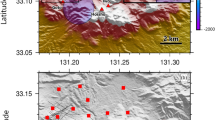Abstract
Time-lapse 3-D seismic monitoring of subsurface rock property changes incurred during reservoir fluid-flow processes is an emerging new diagnostic technology for optimizing hydrocarbon production. I discuss the physical theory relevant for three-phase fluid flow in a producing oil reservoir, and rock physics transformations of fluid-flow pressure, temperature and pore-fluid saturation values to seismic P-wave and S-wave velocity. I link fluid-flow physical parameters to seismic reflection data amplitudes and traveltimes through elastic wave equation modeling and imaging theory. I demonstrate in a simulated data example that changes in fluid-flow can be monitored and imaged from repeated seismic surveys acquired at varying production calendar times.
Similar content being viewed by others
References
K. Aki, and P. G. Richards,Quantitative Seismology, W. H. Freeman and Company: San Francisco, 1980.
M. Batzle, and Z. Wang, “Seismic properties of pore fluids,”Geophysics, Vol. 57, pp. 1396–1408, 1992.
J. P. Blangy,Integrated Seismic Lithologic Interpretation: The Petrophysical Basis, Ph.D. Thesis, Stanford University, 1992.
J. P. Blangy, and S. Strandenes,Stanford Rock Physics Lab Report, Vol. 47, Stanford University, 1991.
T. Bourbié, O. Coussy, and B. Zinszner,Acoustics of Porous Media, Institut Francais du Petrole Publications, 1987.
L. P. Dake,Fundamentals of Reservoir Engineering, Elsevier: New York, 1978.
D. E. Lumley, “Kirchhoff prestack depth migration: Imaging conditions and amplitude recovery,”Expanded Abstracts, 59th Ann. Internat. Mtg., Soc. Expl. Geophys., Dallas, pp. 1336–1339, 1989.
D. E. Lumley, and W. B. Beydoun, “Angle-dependent reflectivity estimation by Kirchhoff migration/inversion,”Stanford Exploration Project Report, Vol. 79, Stanford University, pp. 205–226, 1993.
D. E. Lumley, A. Nur, S. Strandenes, J. Dvorkin, and J. Packwood, “Seismic monitoring of oil production: A feasibility study,”Expanded Abstracts, 64th Ann. Internat. Mtg., Soc. Expl. Geophys., Los Angeles, pp. 319–322, 1994.
A. Nur, “Four dimensional seismology and (true) direct detection of hydrocarbons: The petrophysical basis,”The Leading Edge, Vol. 9, pp. 30–36, 1989.
Author information
Authors and Affiliations
Additional information
I would like to thank Amos Nur, Jack Dvorkin and James Packwood of the Stanford Rock Physics Laboratory for their help with the rock physics component of the synthetic data example. Sverre Strandenes and Norsk Hydro were very helpful in providing the reservoir geology information and fluid-flow simulation data. This work was supported by the Sponsors of the Stanford Exploration Project, under the Directorship of Prof. Jon Claerbout.
Rights and permissions
About this article
Cite this article
Lumley, D.E. Seismic monitoring of hydrocarbon fluid flow. J Math Imaging Vis 5, 287–296 (1995). https://doi.org/10.1007/BF01250285
Revised:
Issue Date:
DOI: https://doi.org/10.1007/BF01250285




